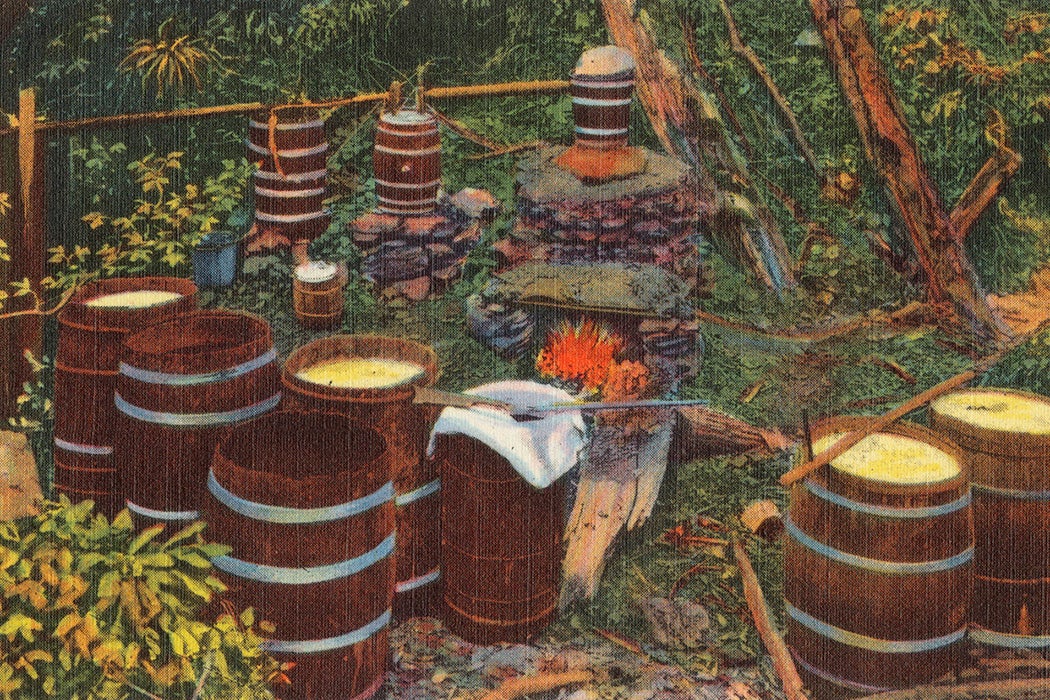About 300 feet up the southern slope of Baker Mountain in White County, Tennessee, the hillside levels out into a wide, grassy bench before climbing again to the summit, about 1,500 feet above sea level. In the 1920s, that strip of land was home to a handful of houses and the entrance to a small cave, now known as George Austin Cave.
Inside, a passageway leads down 60 feet along a rock ledge to a dead end where water drips from a crack in the sandstone wall. A second passageway extends 50 feet to the left to a tiny stream. A century ago, this natural rock formation served as the community’s water source, its refrigerator—electricity wouldn’t even begin to reach rural Tennessee until the mid-1930s—and a hiding place for its moonshine.
Moonshine—usually corn whiskey—was a way of life in Appalachia during Prohibition, as it had been for decades before the 1920 constitutional amendment that made the production of alcohol illegal, and as it would be for decades after its 1933 repeal. Much has been written about the social, economic, and political forces that shaped moonshine culture in Appalachia. To that list, the historian and caver Joseph C. Douglas adds another: topography.
With more than 1,100 caves hidden in the hills and hollers of its 379 square miles, White County in Eastern Tennessee is one of the most cave-dense regions in the world. It was also a center of moonshine production in a state that averaged more than a million and a half gallons a year at late as the 1950s, according to one government estimate.
For legal and illegal distillers alike, caves provided a source of fresh water and cool storage. The Jack Daniels Cave in Lynchburg, Tennessee, has been used in whiskey production since 1866. But for moonshiners, they also provided safe shelter, a hidden and easily defended work space.
Illegal distillers typically worked close to the cave entrance, the easier to transport raw materials and fuel. There, a roughly built square or semi-circular stone furnace would be constructed to heat whiskey mash—typically a mixture of corn, barley, and water—in an enclosed metal cooker. Next to the furnace, a stone platform supported a “thumper keg” and a barrel filed with water. The steam from the vapor from the heated mash flowed from the cooker through a metal tube to the thumper, which filtered out remaining solids, and then through a twisted pipe, known as the worm, which was submerged in the cooling water. In the worm, the vapor condensed into precious liquor.
Evidence of moonshine production, in the form of the ruins of a still or a persistent folktale, can be found around more than 90 caves in Tennessee. In these caves and in others throughout the state one can also find remnants and remembrances of other uses; the caves have been a resource for the region for as long as it has been inhabited. The Woodland Indians used them as burial grounds; industrialists of the late 1700s and early 1800s mined them for saltpeter, an ingredient in gunpowder; and school teachers and preachers of the early 1900s re-purposed them as gathering spaces when summer temperatures rose. Today, many are marketed as tourist attractions. But the caves always had a darker side, too, as a hideout for criminal gangs, guerrilla fighters, and underground distillers.
On Baker Mountain, a Mr. Rich set up his moonshine still about the time that Prohibition became the law of the land. He didn’t use the cave to hide the operation; the still probably didn’t fit well. He located it instead under a rock outcropping about 500 feet from the entrance. But the trickling stream in the cave provided the water he needed and its rock ledge housed the finished whiskey until it could be sold near Chattanooga or in Mussel Shoals, Alabama. According to George Austin, for whom the cave later would be named, Mr. Rich ran moonshine that way for more than 20 years before the still and the whiskey stash were finally raided by the authorities in the 1940s.







